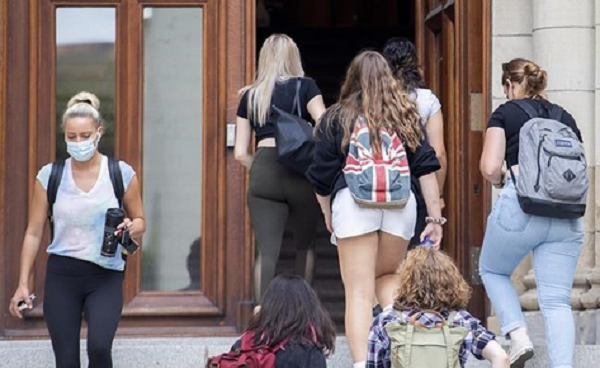StatCan: 60 per cent of international students in Brampton lived in overcrowded housing in 2021
At the height of the pandemic, amidst lockdown and online classes, Monika Mani Khaira said she would navigate through her bedroom with the flashlight from her phone, wary of waking up the two others in her bedroom, or the six others in the basement in Brampton where she lived.
Khaira, a former international student from India who lived in Brampton, said she would have to wait in line to use the bathroom, or wait to cook her food at the one kitchen in the unit, as the nine girls, three to a room, would navigate life in their cramped space.
From 2021 to 2022, she said she paid $400 for the shared room while attending Niagara College.
Though she never felt unsafe, Khaira said she never knew the rules that protected her from living in a precarious and potentially illegal home.
Khaira was one of many international students who lived in overcrowded, unsuitable housing in 2021. A new Statistics Canada study has found Brampton had the highest proportion of international students living in unsuitable homes amongst all cities in Canada. The new report provides figures behind anecdotal reports of foreign students living in cramped, often illegal housing amidst a crunch for affordable accommodation and shed new light on the often blamed population said to be behind the housing crisis.
“International students aren’t doing something wrong. They’re just doing their hard work, paying the rent, paying their expenses,” Khaira said.
“They are the ones who are paying more rent compared to (domestic students). We international students don’t feel ashamed to do any kind of job, we are the ones who provide more labour to this country.”
Many international students live in “unsuitable housing,” StatCan reports
Of the 14,770 international students with study permits in Brampton in 2021, 63.3 per cent lived in unsuitable accommodations based on the National Occupancy Standards, the highest proportion of international students living in overcrowded homes in Canada.
Surrey, B.C., which has a similar international student population, had 61.1 per cent of students living in unsuitable housing.
Meanwhile, in Toronto, 37.2 per cent of the 44,670 international students studying in the city lived in overcrowded accommodations.
The study was based on the most recent census data from 2021.

The new StatCan report comes as Canada continues to grapple with its ballooning international student population, which universities and colleges have relied on for financial stability through high tuition fees for years. Now, that income flow will become a trickle, as the federal government announced in January that it would cut study permits handed out to foreign students by 35 per cent in order to ease Canada’s housing shortage.
Generally, for all students, both domestic and international, housing is already in short supply. A Star analysis of campus housing at 22 post-secondary institutions found that six can’t guarantee rooms for its students and two don’t have residences at all. Algoma University, in Brampton, just unveiled a 500-plus bed residence to help bolster it’s ability to house students, though it won’t be ready until 2028.
Crowded and unsafe housing for international students especially, is nothing new. Unlicensed rooming homes have long been home to recent immigrants and students, and were also often the sites of residential fires. A city report found that 10 per cent of residential fire deaths from 2010 to 2020 occurred in unlicensed rooming homes, a count that includes Helen Guo, an 18-year-old international student studying at the University of Toronto, who died in 2018.
It’s become enough of an issue that the provincial government, in January, mandated that post-secondary schools have to provide sufficient housing for international students.
But it remains unclear, and experts are divided, on whether the new cap on international students and the mandate for housing by the province will alter the housing situation of students from abroad.
The StatsCan report echoes what Luisa Sotomayor, Director of the City Institute at York University, has found in her research. International students, contrary to the narrative that they are the cause of ongoing housing woes, are often victims of a lack of housing, Sotomayor said. Students from abroad come in a rush, oftentimes without knowledge of laws and housing regulations meant to keep them safe.
International students are victims of a housing squeeze: experts, advocates say
International students are often seen as “these cosmopolitan, affluent group, with access to homes in two countries, with a certain level of privilege,” Sotomayor said, but in reality, the population is much more diverse.
“It’s international students who are the most affected by the housing crisis,” Sarom Rho, an organizer with Migrant Workers Alliance for Change, said.
International students, Sotomayor said, often come last-minute in August when the school year starts, in order to save on housing costs, meaning their options are limited, they don’t have the knowledge or connections to be thoroughly briefed on tenant protections, and face additional barriers lacking credit history.
Brampton, specifically, is suburban and has a limited rental market, meaning alternatives outside of university or college dormitories is even more limited than urban centres like Toronto, Sotomayor added.
“So then, what is available are these informal, very underground, overcrowding situations.”
It means students have little option but to turn to listings like one from Facebook Marketplace, posted in June 2023, that advertised for “student girls” to share a room with three other strangers in an East York basement for $600 a month.
And even when students find housing, they can be victimized, Sotomayor said.
Rho, agreed, adding that students have difficulty enforcing their own tenant rights, locking them in their situations.
In an extraordinary circumstance, Sotomayor found that students felt they had no voice in underground and precarious housing arrangements to speak up for their rights, and ultimately feared losing their housing altogether.
“In the longer term, there needs to be more provision of student housing to respond to all sorts of needs — to respond to the needs of students who need to live on campus, but also of students who are more mature and would like different housing arrangements,” Sotomayor said.
This article was first reported by The Star

















